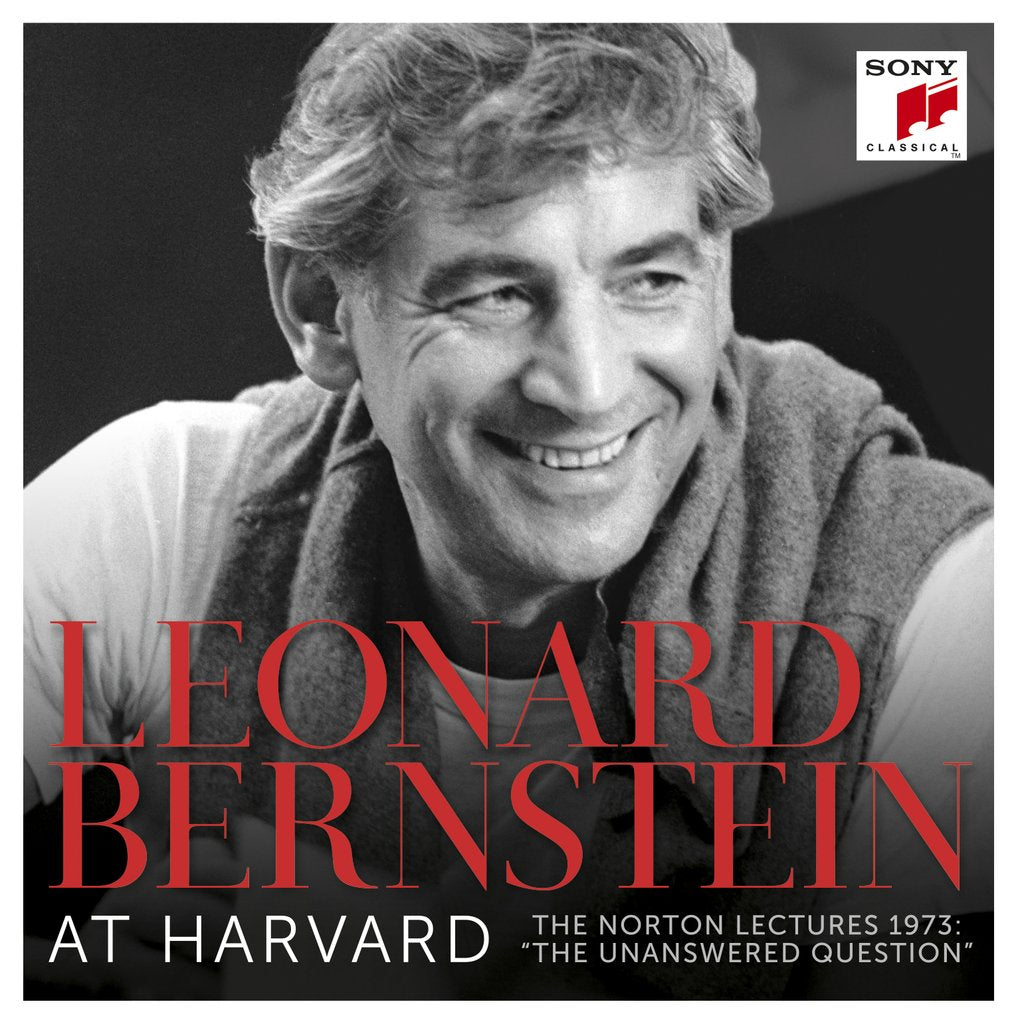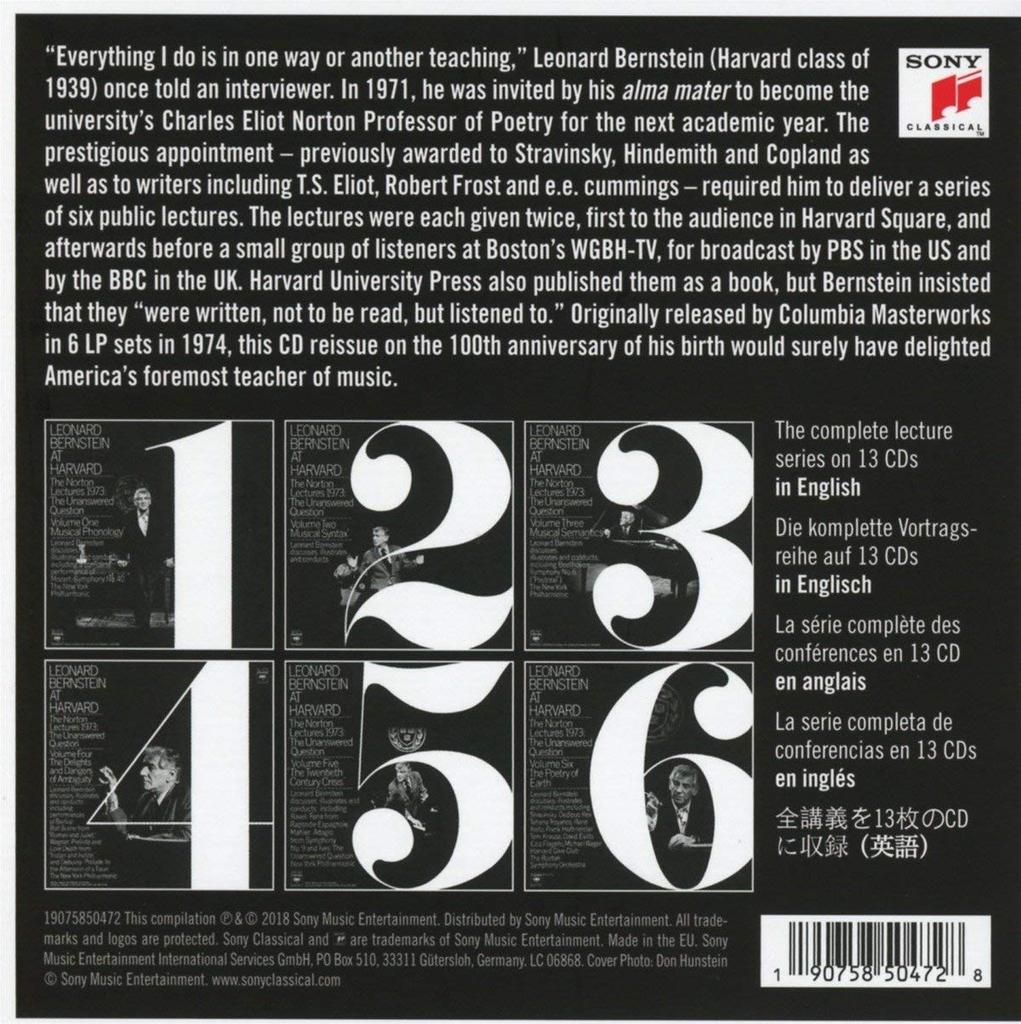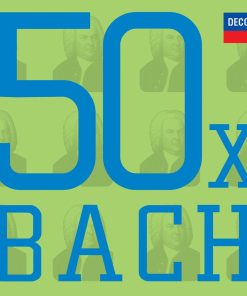LEONARD BERNSTEIN at HARVARD (13 CDS) – THE NORTON LECTURES 1973 “THE UNANSWERED QUESTION” SONY CLASSICS
$ 56,99 $ 28,50

Leonard Bernstein was invited to become the Charles Eliot Norton Professor of Poetry at Harvard University, Cambridge in 1971. This one-year position had previously been held by such notable musical figures as Igor Stravinsky and Aaron Copland. The professorship required Bernstein to live on campus for one school year, counsel students and, most significantly, deliver a series of six public lectures. Bernstein, a “Harvard man” himself, was pleased and honored to become a part of this distinguished tradition.
Bernstein began his residency at Harvard in the fall of 1972. He immersed himself in the academic culture with enthusiasm, and his popularity with students resulted in his being named “Man of the Year” by Harvard’s student newspaper. His daughter Jamie was an undergraduate at Radcliffe at the time, so his involvement in the University’s student life had special meaning for him.
Bernstein was scheduled to give the six lectures in the spring of 1973, but with a full schedule of various composing projects and conducting engagements, he postponed the lectures until the fall. Preparing for the lectures was no small undertaking, and Bernstein wanted to have the time to make the most of this unique opportunity.
Because the lectures embraced such a wide variety of disciplines, Bernstein faced the challenge of organizing his ideas into a coherent progression of six talks. Also, every word had to be written out and memorized because each of the lectures was to be presented twice: live at the University at the Harvard Square Theater, Cambridge, and then in a subsequent taping session for television at the WGBH TV Studios, Boston.
Bernstein based much of the lectures on the linguistic theories Noam Chomsky set out in his book, “Language and Mind.” In the first three lectures, Bernstein analyzed music in linguistic terms phonology (sound), syntax (structure) and semantics (meaning)–focusing on music from the Classical period. In the fourth lecture (“The Delights and Dangers of Ambiguity”), Bernstein looked at music from the Romantic period, with its heightened harmonic uncertainties and structural freedoms. The fifth lecture (“The Twentieth Century Crisis”) outlined the movement toward atonality and the crisis provoked by this crucial change in our musical language. Charles Ives’ “The Unanswered Question,” one of the primary musical examples, became Bernstein’s title for the entire series of lectures. The final lecture (“The Poetry of the Earth”) concentrated on the work of Igor Stravinsky, whom Bernstein thought had found a musical answer to “the unanswered question,” one that kept tonality at its center. The series ended with Bernstein’s artistic and philosophical “credo,” an essentially optimistic and celebratory statement of beliefs.
Although the very breadth of the lectures attracted some negative criticism, they were also widely recognized as an impressive achievement. Lavishly multi-disciplinary long before it was fashionable, they provided a fresh way to analyze music and interpret musical history. The Norton Lectures stand as a special monument in Bernstein’s legacy.

SET CONTENTS
Leonard Bernstein at Harvard, The Norton Lectures 1973:
“The Unanswered Question” in six volumes on 13 CDs
DISC 1-2: Volume 1
“Musical Phonology”; Bernstein discusses, illustrates, and conducts; including a performance of Mozart Symphony No. 40 (previously released on Columbia MS 7029)
DISC 3-4: Volume 2
“Musical Syntax”; Bernstein discusses, illustrates, and conducts
DISC 5-6: Volume 3
“Musical Semantics”; Bernstein discusses, illustrates, and conducts; including Beethoven’s Symphony No. 6 “Pastoral” (previously released on Columbia MS 6549)
DISC 7-8: Volume 4
“The Delights and Dangers of Ambiguity”; Bernstein discusses, illustrates, and conducts; including performances of Berlioz’ Ball Scene from Romeo and Juliet, Wagner’s Prelude and Love-Death from Tristan and Isolde, and Debussy’s Prelude to the Afternoon of a Faun (previously released on Columbia MS 6170, D3M 32992, and MS 6754)
DISC 9-10: Volume 5
“The Twentieth Century Crisis”; Bernstein discusses, illustrates, and conducts; including performances of Ravel’s Feria from Rapsodie Espagnole, Mahler’s Adagio from Symphony No. 9, and Ives’ The Unanswered Question (previously released on Columbia MS 7029)
DISC 11-13: Volume 6
“The Poetry of Earth”; Bernstein discusses, illustrates, and conducts; including performance of Stravinsky’s Oedipus Rex
CBS Records made the entire series available to the general public on November 22, 1974. Each lecture was recorded, complete with Mr. Bernstein’s illustrations at the Piano and with its requisite orchestral examples
Fast Shipping and Professional Packing
Due to our longstanding partnership with UPS FedEx DHL and other leading international carriers, we are able to provide a range of shipping options. Our warehouse staff are highly trained to pack your goods exactly according to the specifications that we supply. Your goods will undergo a thorough examination and will be safely packaged prior to being sent out. Everyday we deliver hundreds of packages to our customers from all over the world. This is an indication of our dedication to being the largest online retailer worldwide. Warehouses and distribution centers can be located in Europe as well as the USA.
Orders with more than 1 item are assigned processing periods for each item.
Before shipment, all ordered products will be thoroughly inspected. Today, most orders will be shipped within 48 hours. The estimated delivery time is between 3-7 days.
Returns
The stock is constantly changing. It's not entirely managed by us since we are involved with multiple parties such as the factory and our storage. The actual stock can fluctuate at any time. Please understand it may happen that your order will be out of stock when the order is placed.
Our policy is valid for 30 days. If you haven't received your product within 30 days, we're not able to issue either a return or exchange.
You are able to return a product if it is unused and in the same condition when you received it. It must also still remain in the original packaging.

























































